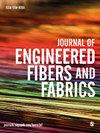织物悬垂系数的简单测量法预测
IF 2.3
4区 工程技术
Q1 MATERIALS SCIENCE, TEXTILES
引用次数: 0
摘要
开发了一种使用简单测量方法预测织物复杂物理性能的方法。为此,对通过传统的织物物理性能测量方法KES-FB和简单的测量方法CLO fabric Kit测量的数据进行了相关性分析,显示出高度相关性。然后,对悬垂系数和KES-FB复杂因素进行多元回归分析,找出对悬垂系数有主要影响的因素。根据这一结果,得到了估算悬垂系数的回归方程。欧几里得距离计算用于从数据库中找到与测量样品最相似的织物,从而预测悬垂系数。最后,证实了实际悬垂系数和预测悬垂系数之间没有统计学差异。本文章由计算机程序翻译,如有差异,请以英文原文为准。
Prediction of fabric drape coefficient using simple measurement method
A method for predicting the complex physical properties of fabric using a simple measurement method has been developed. For this, a correlation analysis was performed between the data measured by the traditional measurement method for the physical properties of fabric, KES-FB, and by the simple measurement method, CLO Fabric Kit, which showed a high correlation. Then, a multiple regression analysis was performed between the drape coefficient and the KES-FB complex factors to find a factor that had a major influence on the drape coefficient. From this result, a regression equation for estimating the drape coefficient has been obtained. Euclidean distance calculation was used to find the fabric from the database that is most similar to the measured sample, from which the drape coefficient was predicted. Finally, it was confirmed that there is no statistical difference between the actual drape coefficient and the predicted drape coefficient.
求助全文
通过发布文献求助,成功后即可免费获取论文全文。
去求助
来源期刊

Journal of Engineered Fibers and Fabrics
工程技术-材料科学:纺织
CiteScore
5.00
自引率
6.90%
发文量
41
审稿时长
4 months
期刊介绍:
Journal of Engineered Fibers and Fabrics is a peer-reviewed, open access journal which aims to facilitate the rapid and wide dissemination of research in the engineering of textiles, clothing and fiber based structures.
 求助内容:
求助内容: 应助结果提醒方式:
应助结果提醒方式:


